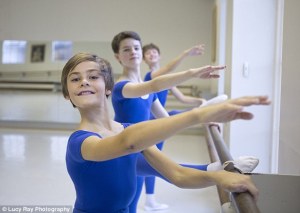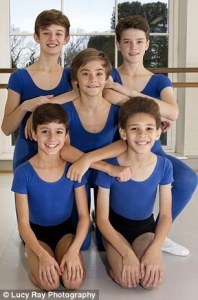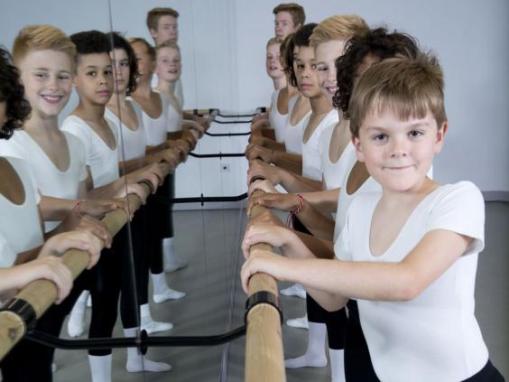The ‘Billy Elliot’ effect sees young males become the ‘crème de la crème’ of the dancing world
More boys attended Royal Ballet School than girls last year
Strictly Come Dancing judge and professional ballerina Darcey Bussell said the UK was producing more male dancers than female
Billy Elliot and TV talent shows are credited as the reason

By Antonia Hoyle
The Daily Mail
December 11, 2015
Toes pointed, arms aloft, the ballet dancers balance perfectly on one leg and lift the other high behind them. The delicate grace of their flowing movements is captivating. With backs ramrod straight, they smile serenely as they glide and twirl across the room. These youngsters are the crème de la crème of the ballet world. Only the best are good enough — and they are intent on perfection.
To help them attain it, instructor Hope Keelan barks instructions as they dance. The smallest indiscretion is noted and brusquely corrected. ‘Fingers and thumbs away,’ she raps. ‘Teeth, teeth! Come on! That was torture.’
It’s astonishing to watch such talent and relentless discipline in ones so young. More astonishing, though, is the fact there’s not a tutu in sight. The leotards of the dancers are blue. And their hair isn’t scraped back into buns, but slicked down in short cuts.

We might be at the mixed-sex Royal Ballet School — Britain’s most prestigious dance training institute — but in this rehearsal studio there are only boys. While little girls still comprise the vast majority of those clamouring to study ballet, boys are increasingly choosing it over ball sports. Last year, there were 112 boys and 109 girls at the Royal Ballet School’s junior and senior branches.
This week ballerina and Strictly Come Dancing judge Darcey Bussell — herself an alumna of the Royal Ballet School — highlighted the remarkable rise of the boy ballet dancer. ‘Every dance school I went to there was only ever one little boy,’ said Darcey, 46. ‘Suddenly, we’re producing more male dancers. Apparently, the problem now is that we’re not producing enough women! How is this possible?’
How indeed?

Some boys have admitted relating to Billy Elliot due to teasing and bullying from other boys
The ‘Billy Elliot’ effect is a factor. After the film — which charted the plight of the fictional 11-year-old miner’s son who won a place at the Royal Ballet School — was released in 2000, much of the stigma around boys and ballet was removed. That shift has been reinforced in recent years by the captivating performances of male ballet stars such as Cuban Carlos Acosta, 42.
‘Shows like Strictly Come Dancing and X Factor have also made dancing more acceptable for boys,’ says Hope, a youthful-looking 60-year-old who seems to inspire both respect and affection from her male students in equal measure. She is artistic teacher and programme manager at White Lodge, the junior wing of the Royal Ballet School. Based in Richmond, South-West London, White Lodge was created in 1955 to produce professional dancers for the Royal Ballet Company.
It is home to 130 boarders aged 11 to 16, one of whom is 11-year-old Blake Smith from Gloucester. He wanted to be a dancer at five, after watching children’s television show Angelina Ballerina.
And he harbours a true passion. He admits he initially encountered opposition to his dreams. ‘I was the only boy in my ballet class and at first my friends would tell me ballet is for girls. But eventually they got used to the idea.’
Blake’s mum Siobhan, 37, was, nonetheless concerned when her little boy started ballet classes. ‘Within two months he’d completed his first competition. I was amazed and proud, but worried he’d be picked on,’ says Siobhan. ‘But Blake says he doesn’t care what anyone else thinks.’

The Royal Ballet School fees cost £30,000 per year and only the best dancers are accepted
Two years ago, Blake was spotted at his local dance class and invited to audition for White Lodge. Competition is fierce. More than 1,000 youngsters vie for two dozen places at the boarding school each year. And the fees — £30,000 a year — are as substantial as the talent.
Like 80 per cent of White Lodge’s students, Blake is given a government grant. ‘Without the grant, there’s no way I would have been able to afford it,’ says Siobhan, a cleaner who split up with Blake’s father while she was pregnant.
She admits the prospect of sending her boy across the country for weeks on end filled her with anxiety. ‘I didn’t want him to go. I know it is an amazing opportunity, but I felt physically sick as I left him for the first time. I’m still struggling.’ She and Blake Skype each other each day. ‘As soon as we’ve finished speaking I cry,’ she says. ‘He’s always been focused, but I worry about how he’ll handle the pressure.’

Boys sandwich four hours of ballet practice a day on either side of their academic studies
Indeed, the pursuit of excellence here is relentless.The boys sandwich four hours of ballet practice a day on either side of their academic studies. Their warm-up alone is characterised by ‘blood, sweat and tears’, says Hope, without hint of apology.
‘Assessments’ are held at the end of the year to boot out underperformers. Less than half of students will progress to the upper school, and fewer still will be accepted into the Royal Ballet.
While the boys insist the girls — who train separately because of their different physical strengths — don’t begrudge their increasing dominance, 11-year-old Caspar Lench lets slip that relationships between the sexes can be strained. ‘At the start of the year the boys and girls didn’t exactly get on,’ admits Caspar, also in his first term. ‘The girls didn’t want to be friends with the boys and the boys were a bit shy around the girls.’ Fortunately, things picked up. ‘After a few weeks we made friends and it’s not awkward any more.’
Caspar started ballet lessons at three after his mum Yasmin spotted his potential while he was playing a sheep in his nursery nativity play. ‘He smiled all the way through, showed no nerves and made everyone laugh,’ says Yasmin, 42.
Like her husband Tristan, 44, Yasmin is a doctor, and their son’s talent came as a surprise. ‘Dancing definitely doesn’t run in the family, but Caspar has always loved performing,’ she says.
Yasmin credits competitors on shows like Britain’s Got Talent with inspiring boys’ ballet dancing ambition, as well as footballers such as England star Rio Ferdinand, who have been open about practising ballet as youngsters.
What about Billy Elliot? ‘I do sort of relate to him, but feel like it was easier for me because I had my parents’ encouragement,’ says Caspar.
Yasmin acknowledges her son was lucky to only receive a couple of barbed comments from peers who described his hobby as ‘girly’. And she adds: ‘I think Tristan being supportive helped. We know of other boys who have dropped out because their dads didn’t approve.
‘I knew it would be sad for us to say goodbye to him but, by the time he was seven, he was showing such promise we had an inkling he would go to ballet school.’

Annually, more than 1,000 youngsters vie for only two dozen places at the Royal Ballet School
Auditions for Royal Ballet School are held at the beginning of the year, with staff scouring the country for the best of the best. Every aspiring student is invited to take part in a dance class where their talent is assessed. Caspar’s audition was at a church hall near his home city of Bristol with a final audition at White Lodge this January. A week later, he discovered he’d been accepted.
As the term started in September, he managed to maintain a stiff upper lip, despite the fact he faced weeks without his mum, with all visits pre-arranged. ‘He made it very clear he didn’t want me to cry and embarrass him,’ says Yasmin. ‘But the school prepared us for the fact the children can get homesick.’
In fact, says Hope, the boys are more susceptible to homesickness — or more likely to show it. ‘Girls are a bit more able to mask their feelings,’ she says, adding that despite the discipline, she would never tell a lad missing home he wasn’t entitled to feel sad.
‘We talk about their feelings. I think boys show pressure differently if they’re angry or upset. They cry or they’ll fight. I say they need to see a nurse, and we have psychology workshops.’
Caspar admits he’s found his first term heavy going. ‘When things have happened — I’ve had injuries and arguments and stuff — I’ve wished Mum could be here to sort it out and I call her and cry.’
They speak for half an hour every evening. ‘If I’m feeling sad, she will say she is hugging me down the phone.’
Yasmin doesn’t find his homesickness quite as easy to brush off. ‘I know Caspar bounces back quickly, but I still feel anxious,’ she says. ‘I worry about the pressure and how he would cope if he lost his place. I like to think he is strong, but it would be a blow for him.’

While all the boys have a certain air of vulnerability, it’s also striking how composed they are. ‘There is an emphasis on professional behaviour here,’ explains Isaac Martin, 13, from London, who is in his second year.
Isaac, whose dad Leo, 49, is a company manager and mum Catherine, 45, a museum curator, was a gymnast before discovering ballet a couple of years ago. He admits that at the end of a hard day’s practice, everything aches, but he wouldn’t dream of complaining: ‘We’re taught to respect our elders, that we’re here to learn and not to make a fuss. It’s a good motto to live by.’

And it is quite extraordinary that despite being in stiff competition with each other, the boys show no signs of jousting or one-upmanship. Are there really no squabbles? ‘Only in our dorms,’ chips in 12-year-old Stanley Young, who has also just entered year two. ‘And mostly over things like the shower rota. But it’s always sorted out.’
It sounds like Stanley, from Leamington Spa, Warwickshire, whose parents are Sarah, 49, and Steve, 45, an engineer, has found an acceptance through ballet school he previously lacked. ‘Because I didn’t like football I felt isolated and different from the other boys,’ he says. These days, Stanley shares his section of the boys’ dormitory with Sacha Barber, 12, from Eastbourne.

You always have to be better than you were the day before’ is the mantra boys are taught at the RBS
Sacha admits he is finding his second year more stressful than his first and that his dad Daniel, 48, a carpenter, is ‘still surprised’ by his love of dance. ‘You don’t get pushed as much until second year,’ says Sacha — the only boy permitted to sport a longer hairdo, because he is playing Fritz, the lead role in the Nutcracker at the school’s annual performance now taking place at the Royal Opera House. Apparently, he needs longer locks to look suitably Victorian.
But he refuses to buckle under the increased pressure of the second year: ‘I just try harder.’ And it is this which is the unspoken mantra of all the boys at The Royal Ballet School. Without exception, they handle mounting pressure with remarkable grace.
‘It is stressful,’ says Caspar as rehearsals end. ‘You always have to be better than you were the day before and I don’t always achieve that. But you have to work hard and hope for the best.’
Copyright 2015 Associated Newspapers, Ltd.















